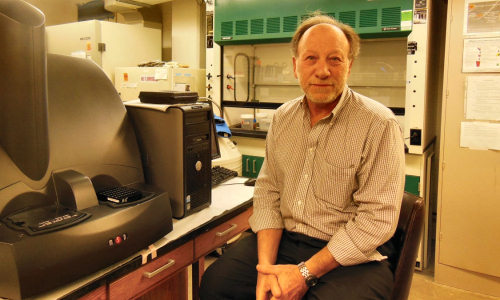Like rings of a tree, hair can reveal a lot of information about the past. It can tell if a person recently used drugs or an athlete was doping. It can provide information about hormones and expose environmental toxins.
Christopher Coe, UW-Madison professor of psychology and director of the Harlow Center for Biological Psychology.
And, as a team of University of Wisconsin-Madison researchers show in a study of rhesus monkeys, published in the April 2014 edition of the journal Pediatric Research, it can also reveal the womb environment in which an infant formed.
It’s the first time researchers have used infant hair to examine the hormonal environment to which the fetus was exposed during development and it promises to yield a wealth of new information. The findings have significant implications for several fields, from neonatology to psychology, social science to neurology.
“We had this ‘Aha!’ realization that we could use hair in newborns, because it starts growing one to two months before birth,” says Christopher Coe, UW-Madison professor of psychology and director of the Harlow Center for Biological Psychology. “It provides a glimpse of the prenatal hormone environment.”
Hair closest to the scalp reveals the most recent information but moving down the shaft effectively transits an individual’s hormonal timeline.
For the noninvasive study, researchers took small samples of hair from mother rhesus monkeys and their infants using common hair clippers. The hair was cleaned and pulverized into a fine powder using a high-speed grinder. The hormonal signature was then read using a new mass spectrometry method.
The researchers were interested in whether there were differences in the hormones of infants born to younger, first-time mothers versus more experienced mothers. To test their question, they compared monkey mothers equivalent in age to 15-year-old humans to older monkeys, similar in age to pregnant young adults.
“It provided a model of teenage pregnancy,” says Coe. “You’re still growing yourself and if you’re 15 and pregnant, mom and developing baby are more in competition with each other.”
The researchers used rhesus monkeys because they are an ideal model species for humans.
It’s well known that maternal age plays a role in pregnancy and delivery outcomes, and a growing body of evidence shows that levels of some hormones — such as the stress hormone cortisol and female-typical hormones like estrogen — are higher in young mothers and younger women pregnant for the first time.
Prior studies have shown high levels of cortisol and drugs that act like it can have a lasting impact on the developing brain, including impairment in reflexes and attention, and an increased incidence of emotional and learning problems.
In the monkey study, researchers found that cortisone, an inactive form of cortisol, was higher in young mothers and in their babies than in hair of the older mothers and their infants.
Babies born to young mothers also had higher levels of estrone (a form of estrogen) and testosterone in their hair than did babies born to older mothers. Levels of both these hormones were surprisingly similar between male and female infants.
Both Coe and Amita Kapoor, first author of the study and former postdoctoral researcher in Coe’s lab, are particularly interested in whether these differences impact “maleness and femaleness” of the babies: whether higher exposure to these steroid hormones during fetal development leads to more pronounced gender differences in behavior later in life.
The findings raise questions about everything from the significance of birth order to stereotypical “boy” and “girl” behaviors in children.
Additionally, what happens to a developing fetus while in the womb may impact its risk for chronic disease later in life, says Kapoor.
“Type 2 diabetes, metabolic disease, coronary artery disease, psychiatric disorders — there [may be] a whole host of long-term repercussions of stress in utero,” says Kapoor, now an assistant researcher at the Wisconsin National Primate Research Center’s Assay Services.
She referred to a theory proposed by the epidemiologist David Barker, which suggests the developing fetus may be “programmed” in response to the womb environment.
Those who study people are “really excited because it’s so noninvasive,” Kapoor says, although getting enough hair from humans is a challenge researchers have nearly, but not quite, figured out. Most human babies aren’t as hairy other primates.
For the rhesus study, Kapoor — working with colleague Curtis Hedman, of the Wisconsin State Laboratory of Hygiene — was able to refine a new method for looking at multiple hormones at a time. She was able to analyze eight hormones simultaneously and is now working to increase that number.
For Coe, this “proof-of-concept” study provides a new world of opportunity. Because hair is non-toxic and stable at room temperature, it’s easy to store and easy to transport.
“How does the prenatal environment set the stage for risk or for resilience?” he asks. “The new collaborations are an unexpected gift. It’s more than just cool technology or a cool idea.”
Story Source:
The above story is based on materials provided by University of Wisconsin-Madison, Kelly April Tyrrell.





